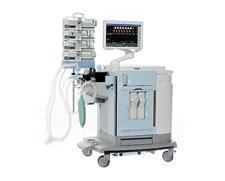
Categorised under:
Anaesthesia
>
Ventilators
>
Anaesthetic ventilators

Did you know you can Register for FREE with this website?
Registration gives you full access to all of the features of WhichMedicalDevice. Find out more ...
WhichMedicalDevice is a FREE resource created by clinicians for clinicians.
Registration is free and gives you unlimited access to all of the content and features of this website.
Find out more...Registration is free and gives you unlimited access to all of the content and features of Which Medical Device. Find out more...
Which Medical Device is a community of clinicians sharing knowledge and experience of the devices and procedures we use on a daily basis. We ask that our members register with us so that we can maintain the unbiased and independent nature of our content. Registration is quick and free.
We do not make your details available to any third parties nor do we send unsolicited emails to our members. You can read our Privacy Policy here.
Comments
Comment by vladocernak Commented Feb 14, 2013
Impact factor: 12
User Rating
We used the machine in pediatric cardiac anesthesia setting. In our setting ( children less than 5 kg) the ventilator didn't correctly measure the tidal voluminas. The difference was more than we were willing to accept. I would like to know if anybody encountered similar problems. I absolutely agree with the comments that the machine could be more usersfrendly
Comment by iccuconsultant Commented Nov 7, 2012
Impact factor: 14
User Rating
We have 2 Zeus vents in a drager fleet which consists primarily of Primus machines (in theatre) and fabius machines (in anaes rooms).
The Zeus is not a machine to replace a standard ventilator, it does not function in the same way that even the most modern Boyles inheritance machines function. It is not intuitive to use and requires adequate training (which drager seem happy to provide). It is not a machine to leave a junior trainee with and can be difficult to troubleshoot if the anaesthetist is unfamilar with its unconventional aesthetics and interface.
Those already using drager machines (particularly in ICU) will have a distinct advantage when first confronted with the Zeus in that much of the touchscreen interface shares the same basic embryology.
Would I recommend the machine? If you have a list of quick turnover spontaneously ventilating patients to anaesthetise the Zeus underperforms the opposition in ease of use and speed to steady state anaesthesia. If you have an all day robotic prostate, whipples or hepatic transplant to anaesthetise then the efficiency of the autoflow system coupled with the rapid flushing of volatile at anaesthetic completion make the Zeus by far the best machine for using expensive agents with (desflurane). As the Zeus regularly gets to flows less than 100ml/min and has a herculean autoflush the % of volatile can drop to zero within seconds of setting the autoflow target.
In summary, the Zeus is not a training machine, or a replacement for efficient yet user friendly machines such as the Primus. The Zeus is perfect for long cases where expensive volatiles are to be used and is an extremely efficient (and cost effective) machine if used in such a role.
There are clinical governance issues of having a mixed fleet of machines and prior to acquiring this (expensive) piece of equipment a department needs to consider the implementation of a rolling training and competency programme.
Comment by anaesthetics Commented Feb 4, 2012
Impact factor: 12
I note the previous reviewer (colleague)ís comment. Our department of Anaesthetics purchased several Zeus machines a few years ago to supplement our fleet of Drager Fabius and Primus IE models. Training on these new machines was thorough and extensive and Drager worked tirelessly to provide a full education programme for the consultant and trainee body.
Some of the positive feedback included having sophisticated ventilation modes, increased efficiency due to auto control and TCA (target controlled anaesthesia) and being well suited for research. Other feedback included the issues of: having a mixed fleet of anaesthetic machines; ensuring a robust training programme (for consultants, trainees who rotate every 6 months and locums who come to work in our theatres); maintaining familiarity and skills (a small number of the Zeus machines in the midst of a large consultant body where a significant portion have non-fixed theatre sessions); and, an increased complexity in the operation of the Zeus machine.
The department continues to have an extremely good working relationship with Drager and is grateful for their training and technical support.
Comment by bphilips Commented Jan 25, 2012
Impact factor: 14
User Rating
This is anaesthetic machine is full of good ideas and has a great ventilator, particularly for the more complex patient. However it has many, many problems. If it does stop working and it will, identifying the problem quickly is virtually impossible. It is not intuitive when the there are problems and total loss of ventilation is possible.
Unless it has been changed there, the need to press the confirm button is too frequent even in standard use and it is possible to think you have confirmed settings but actually you find you didn't press the confirm button either often enough or firmly enough. In short, excellent machine when life is being predictable, disaster in the making when some thing unexpected happens